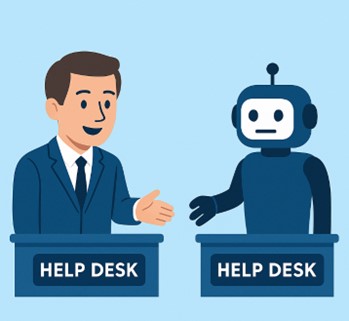Have you ever had the experience where customer service tries to get you to use a chatbot (“the online service has all the information our representatives have”), but you know it’s not going to answer your question and you just want to get to a human? That got me wondering: are chatbots actually improving the customer experience, or are they just one more hoop we have to jump through?
It turns out that, while many companies are racing to adopt AI for customer service, research shows that customer satisfaction hinges on how AI is used – not whether it’s used at all.
AI can be brilliant – when it’s used thoughtfully. Across industries, AI is quietly powering some truly impressive improvements in customer experience. For example:
- Sephora uses an AI chatbot to recommend makeup based on your skin tone, weather, and preferences. Customers say it feels like having a personal stylist on call.
- Capital One’s AI assistant, Eno, flags suspicious charges or unexpected fees before you even notice. That kind of proactive help builds trust.
- Tripadvisor now offers an AI-powered itinerary planner that can build a multi-day travel agenda based on your interests, budget, and travel dates—all in seconds.
These tools work well because they respect the customer’s time and reduce friction. They enhance the experience without replacing the human touch entirely.
However, AI doesn’t always lead to great customer service. Customers expect to escalate to a human when needed – a but many chatbots don’t make that easy. Forrester found that fewer than 20% of chatbot interactions are fully resolved without human support. In other words, customers are often left feeling stuck. And when that happens, satisfaction drops. Fast.
The problem isn’t AI itself – it’s poor implementation:
- Bots that can’t understand nuance
- Rigid, rule-based scripts
- No clear way to “talk to a person”
- Privacy and data concerns
What works best is the “human-in-the-loop” model: AI handles the repetitive, high-volume tasks, and humans step in for the complex, emotional, or nuanced ones. That is, AI works with humans, not instead of them.
MetLife, for example, uses AI to listen in on service calls and provide live coaching to agents – suggesting responses or flagging when a customer sounds frustrated. The agent stays in charge, but gets a digital co-pilot. That’s a smart use of AI. It boosts speed and empathy.
If you’re considering how to use AI to improve your company’s customer experience, here are three places to start:
- Look for friction: Where are customers getting stuck, delayed, or dropped? AI can help – but only if you’ve clearly mapped those trouble spots first.
- Respect escalation: Don’t make customers “prove” they deserve to talk to a human. Make the human option easy, fast, and friendly.
- Keep it transparent: Let people know when they’re talking to a bot. Let them know what the bot can and can’t do. Set expectations up front.
And finally: make sure your AI is improving the emotional experience – not just the technical one.
The bottom line: AI can absolutely improve customer experience. But it doesn’t always. The difference lies in whether the tool is designed to make customers feel more understood – or just more processed.
Like most things in business (and life), tech works best when it’s paired with a human mindset. That means empathy, curiosity, and a deep understanding of what your customers actually need.
Want to know more about how AI can improve the customer experience at your company? Ask about our presentation “AI-Driven Customer Experience: Unlocking Loyalty, Retention, and Growth.” Email me at info at bureauwest.com.
Sources: “Consumer Insights: Trust In AI In The US, 2024,” Forrester, October 6, 2024; Bureau West research



